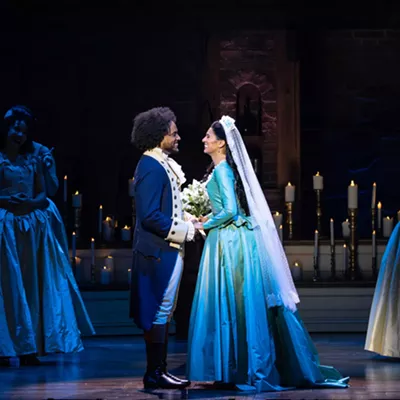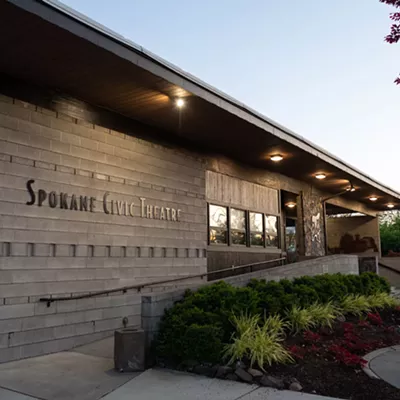At 8 pm, the border crossing just north of Metaline Falls closes. While this change in hours might seem pragmatic — traffic is slow — the reduced hours have hurt attendance at the Cutter Theatre in Metaline Falls. Canadians used to attend performances; now, unless they commit to an overnight stay, they can't. In an isolated community with sparse resources, small obstacles like this stack up and become insurmountable. The Cutter Theatre has fallen on hard times.
Cynics might say, "Sad, sure, but is a struggling theater that important?" As important, for example, as the nearby zinc mine remaining viable and open? Is the theater as important as a having a viable organic grocery store or a nearby health clinic? Maybe the theater is just a casualty of shifting values. Maybe theaters are no longer necessary in a world where people can connect virtually. Maybe theaters are just vestigial reminders of bygone days.
Maybe. But maybe this theater — what many people referred to as the town's heart — and its decline should be considered integral to understanding overall community well-being, as important a litmus test as decreased employment opportunities and health care access. Maybe these problems are all connected — opioids and unemployment, suicide rates and empty stages. Maybe from Forks to Asotin, Curlew to Cathlamet, the presence of cultural energy, an enthusiasm for the arts, can be both indicative of the overall health of the small town and part of a route toward a more healthful future — which makes the situation in Metaline Falls even more troublesome.
Or maybe look at it one more way. Suzanne Ostersmith, professor of theater arts at Gonzaga, offers this: "It might be tempting for some to think theater only belongs in city centers, but I disagree. Some of the most engaged and life-changing theater I have witnessed has been in rural communities." Life-changing is a powerful phrase — and it's one that's often used in connection with the arts.
To sum in a sentence: A schoolhouse designed by one of our region's most celebrated figures, the building that became the Cutter Theatre and symbolized numerous awards a small community in the Selkirks earned (in music education, as an arts town), the structure which is, perhaps, representative of North Pend Oreille County's prosperity, and, thus, metonymically, the cultural well being of many of our region's small towns, that schoolhouse, that particular theater needs a new roof.
In 1912, Metaline Falls was growing. The arrival of rail lines, the abundant timber and lucrative mining resources provided opportunity and jobs. By 1930, the population would rise from 150 to over 800. Consequently, the town needed a new school, and prominent architect Kirtland Cutter obliged with a design. Such projects weren't a side hobby for Cutter. Henry Matthews, former architectural historian at WSU, explains: "Cutter's firm's eclectic creations became architectural emblems for the frontier merchants and magnates. His mission was to civilize many of the grimy towns born of mining and new commerce. He really cared about making beautiful places that expressed peoples' dreams." Although Matthews' word "grimy" (and its biases) offends, Cutter's egalitarian principles do not: access to the arts, the beautiful, is something that everyone deserves.
The Metaline Falls school stayed open until 1972, when consolidation forced a new building. After temporarily housing the district's offices, the building closed until 1990 when Eva Gayle and Al Six of Ione, Washington, along with a host of other local arts enthusiasts, purchased the building. It was reborn as the Cutter Theatre. To repair the damage of a decade (and to update accessibility issues), the building underwent a massive renovation. Utilizing National Endowment for the Arts funds, a Community Development Block Grant and an energized local volunteer force (providing over 14,000 hours of volunteer work), the school transformed into a cultural destination in the northeast corner of the state.
Tara Leininger, mayor of Metaline Falls and former theater director, describes the synergistic forces that led to this renaissance: "The three North Pend Oreille communities, Ione, Metaline and Metaline Falls, have always had the arts in high regard, or at least I would say they used to. When we moved here, a thriving amateur theater group had just purchased the shuttered school building for not only its own theater, but also for a county library branch; included in the renovation plans were a gallery space, and a space for an after-school arts program and a working space for artists. A few years later, in 1998, when Metaline Falls was named one of the 100 small art towns in whole country, we weren't surprised."
Other awards for the theater and community would follow — including recognition for its strong music education program. Additionally, the performance list at the theater was impressive: Celtic music, Russian orchestras, street dancing troupes, eclectic puppets, poetry readings, and many, many plays were staged at the Cutter — including musicals. Leininger continues, "I remember going to a conference on education in Seattle; a speaker was going to address theater programs in small town schools. One of the first things that he said was, 'If your budget isn't at least $17,000, then forget about musicals.' I listened for a few more minutes and then stood up and said, 'Our budget isn't much more than $1,500, and we've staged many musicals; anyone who wants to talk about how to do that, grab your coffees and let's go find a place to talk.'" Leininger says that about half the people in the room followed her out — which says a lot about her charismatic and stubborn spirit, as well as privileged ideas about the arts, education and funding.
Today, the theater is still operational; a murder-mystery dinner theater run just ended; open mic and impromptu events unfold on weekends. Chris Daley runs a hair salon in one of the classrooms on the main floor of the building. Open three days a week, it's one of several businesses with offices that contribute to keeping the lights on. Daley says, "It's really the heart of our community. It's everything. I've been to so many great events there; my favorites are probably The Sound of Music and some of the other musicals." Her children have performed on the stage, and she says that she's even put aside her reservations and acted in a play. "I was nervous, but it was a lot of fun."
Those local performances and outside bookings may become a thing of the past.
"Where the Cutter used to be able to book performers of a variety of kinds, these events are no longer possible due to shrinking audience attendance and financial support," Leininger says. "The support of the arts is very important to a core group in the area, but I can't say that it is a community-wide support any longer, or a source of pride as it once was." And there is the most pressing problem: The building desperately needs a new roof, a project that will cost nearly $100,000.
Other regional small towns face similar predicaments. In Newport, CREATE, a community arts organization, struggles to attract young people. Joyce Weir, a member, questions the sustainability to provide the community with creative programming, something she thinks is incredibly important: "Education in the arts enhances the ability to learn other academic subjects, create something new, and participate in a community where each person's efforts are accepted and appreciated."
"It's really the heart of our community. It's everything. I've been to so many great events there."
Further, what Weir calls "the national obsession with sports" also plays an issue. Chris Daley agrees: "You can't schedule things at the theater that might compete against football or sports. It also keeps the kids from participating like they used to." Phones and social media, screen culture writ large, also play roles. Of course, these classroom problems aren't just found in rural areas, but they might have more impact on small communities with small populations from which to draw. And the loss isn't just numerical. Leininger can list successful students from Selkirk School District — a Stanford scholarship for a theater major, a talented student performer finding her way to bigger stages. Leininger adds, "Now, I can't get the young people involved. Our numbers are down. They just want to stare at screens."
A repeat visitor to the theater, internationally renowned pianist George Winston, plans to return for a benefit concert next year.
"It is always so great to play at the Cutter Theatre," Winston says. "The piano and acoustics and audience are all so great, and it is also very inspiring to be in that part of the world as well. I love playing in small towns with an intimate audience, and I try to play in every town possible in the country, especially in places where most touring artists don't get to. We will do a benefit concert for the theater repair the next time I am there, hopefully in September 2019."
Further, Leininger is cautiously optimistic about getting Department of Homeland Security to reconsider border hours — and the soon-to-open casino in Cusick is a valuable lobbying partner to achieve this change.
However, funds from a well-attended concert and a few more culture-seekers from across the border, while helpful, hardly solve the issues with students, sports, and screens (and don't forget the leaky roof). Grant money is hard to come by, and philanthropy seems driven by utilitarian concerns.
"Twice the Cutter was turned down for foundation money from a certain multibillionaire because 'we didn't impact that many people,'" Leininger says. "In other words, a $10,000 gift would be better spent in Seattle or Spokane than in Metaline Falls, with its tiny population and limited resources. The people of the north county deserve the arts as much as anyone else." ♦
From 2016-18, Tod Marshall, a Gonzaga University professor, served as the Washington state poet laureate, sponsored by Humanities Washington and Arts Washington.




















